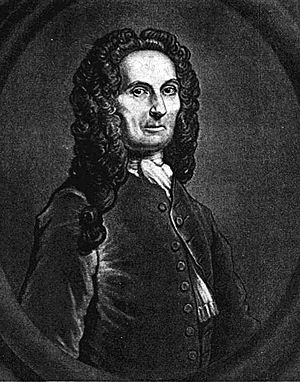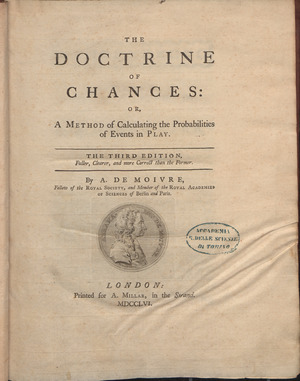Abraham de Moivre facts for kids
Quick facts for kids
Abraham de Moivre
|
|
|---|---|
 |
|
| Born | 26 May 1667 Vitry-le-François, Kingdom of France
|
| Died | 27 November 1754 (aged 87) London, England
|
| Alma mater | Academy of Saumur Collège d'Harcourt |
| Known for | De Moivre's formula De Moivre's law De Moivre's martingale De Moivre–Laplace theorem Inclusion–exclusion principle Generating function |
| Scientific career | |
| Fields | Mathematics |
| Influences | Isaac Newton |
Abraham de Moivre was a French mathematician. He is famous for his work with complex numbers and trigonometry, especially de Moivre's formula. He also made big contributions to probability theory and understanding the normal distribution.
He moved to England when he was young. This was because Huguenots (French Protestants) faced harsh treatment in France. This bad treatment became very serious in 1685.
De Moivre was friends with other famous scientists like Isaac Newton and Edmond Halley. He also worked with Pierre des Maizeaux, who was another Huguenot exile.
He wrote an important book on probability called The Doctrine of Chances. Gamblers especially liked this book. De Moivre was also the first to find a way to calculate Fibonacci numbers using a special formula. He also helped create the idea of the central limit theorem, which is a key part of probability.
Contents
Life of a Mathematician
His Early Years
Abraham de Moivre was born in Vitry-le-François, France, on May 26, 1667. His father, Daniel de Moivre, was a surgeon. He believed that education was very important.
Even though his family was Protestant, Abraham first went to a Catholic school. This was unusual because of the religious tensions in France at that time. When he was eleven, he went to the Protestant Academy at Sedan. There, he studied Greek for four years.
In 1682, the Protestant Academy at Sedan was closed. De Moivre then studied logic at Saumur for two years. He read many math books on his own, even though math was not part of his main studies. He read works by Jean Prestet and Christiaan Huygens. In 1684, de Moivre moved to Paris. He started taking private math lessons from Jacques Ozanam. This was his first formal math training.
Religious problems in France got much worse in 1685. King Louis XIV took away the rights of French Protestants. He made Protestant worship illegal. All Protestant children had to be baptized by Catholic priests. De Moivre was sent to a school called Prieuré Saint-Martin-des-Champs. This school was for Protestant children to be taught Catholicism.
It's not clear exactly when de Moivre left this school. Records show he left in 1688. But he and his brother were in London by August 1687.
Life in London
When de Moivre arrived in London, he was already a skilled mathematician. He knew many important math books. To earn money, he became a private math tutor. He would visit students or teach in London's coffee houses.
He continued his math studies after seeing Isaac Newton's book, Principia Mathematica. De Moivre realized this book was much deeper than what he had studied before. He decided he had to understand it. He had little time to study because he walked a lot between students. So, he tore pages from the book and carried them in his pocket. He would read them between lessons.
There's a story that Newton, later in his life, would send people with math questions to de Moivre. Newton would say, "He knows all these things better than I do."
By 1692, de Moivre became friends with Edmond Halley. Soon after, he became friends with Newton himself. In 1695, Halley shared de Moivre's first math paper with the Royal Society. This paper was about Newton's ideas on "fluxions" (early calculus). It was published that same year.
De Moivre also made Newton's binomial theorem more general. The Royal Society learned about his new method in 1697. They elected de Moivre as a Fellow on November 30, 1697.
Despite his success, de Moivre could not get a job as a math professor at a university. This would have freed him from tutoring. One reason was likely a bias against his French background.
In 1712, he joined a group set up by the Royal Society. This group looked into who discovered calculus first, Newton or Leibniz.
De Moivre remained poor throughout his life. He was known to play chess at Old Slaughter's Coffee House. He earned a little money from these games.
His Later Years
De Moivre kept studying probability and math until he died in 1754. Some of his papers were published after his death. As he got older, he became more tired. He needed to sleep longer each night.
There's a story that de Moivre noticed he was sleeping an extra 15 minutes each night. He supposedly calculated that he would die on the day his sleep time reached 24 hours. This date was November 27, 1754. He did indeed die on that day in London. His body was buried at St Martin-in-the-Fields. However, many people say this story about him predicting his own death is not true.
Probability and Math Discoveries
De Moivre was a pioneer in probability theory. He built on the work of others like Christiaan Huygens. He wrote the second textbook on probability theory, The Doctrine of Chances: a method of calculating the probabilities of events in play. The first book on games of chance was written by Gerolamo Cardano in the 1560s.
De Moivre's book came out in several editions. In later versions, he included his discovery from 1733. This was the first time someone described how to approximate the binomial distribution using what we now call the normal distribution. This was a very important step in understanding errors and probabilities. He also used these ideas for gambling problems and insurance calculations.
Calculating "n!" (n factorial) for large numbers was hard before calculators. In 1733, de Moivre suggested a formula to estimate it. He found an approximate value for a constant in the formula. Later, James Stirling found the exact value for that constant.
De Moivre also wrote about "Annuities upon Lives." In this, he showed how the death rate changes with a person's age. He created a simple formula to estimate how much money annual payments (like from an insurance policy) would bring in based on a person's age. This is similar to what insurance companies use today.
De Moivre's Formula
In 1707, de Moivre found an important equation. From it, you can figure out:
He proved this for all positive whole numbers n.
In 1722, he showed equations that lead to the more famous version of de Moivre's Formula:
This formula is very important. It connects complex numbers and trigonometry. It also helps find useful ways to express cos(nx) and sin(nx) using cos(x) and sin(x).
Stirling's Approximation
De Moivre's work in probability often required him to calculate factorials (like 5! = 5x4x3x2x1). For very large numbers, this was difficult. In 1730, de Moivre published a book that included tables for log (n!).
He also found a way to estimate certain terms in a binomial expansion for large numbers. A binomial expansion is what you get when you multiply out something like (a + b) to the power of n.
On June 19, 1729, James Stirling sent de Moivre a letter. It showed how he calculated a specific term in a binomial expansion for large values of n. In 1730, Stirling published his own book. It included his formula for log (n!):
-
 ,
,
This means that for large n, n! can be estimated as:
-
 .
.
In 1733, de Moivre published a pamphlet. In it, he thanked Stirling for his letter. He also suggested another way to estimate the central term of a binomial expansion.
Celebrating His Work
On November 25, 2017, a special meeting was held in Saumur, France. It celebrated 350 years since de Moivre's birth. He had studied in Saumur for two years. The meeting was called Abraham de Moivre: The Mathematician, his life and his work. It focused on his important contributions to complex numbers and probability theory.
The meeting talked about de Moivre's life and his move to London. There, he became a respected friend of Isaac Newton. Even so, he lived simply. He earned some money by advising gamblers at the Old Slaughter's Coffee House. He would tell them about the chances of winning their games!
On November 27, 2016, another meeting was held in Limoges, France. It marked 262 years since de Moivre's death. This meeting discussed his famous approximation of the binomial law. This idea later inspired the central limit theorem.
See also
 In Spanish: Abraham de Moivre para niños
In Spanish: Abraham de Moivre para niños
- De Moivre number
- De Moivre quintic
- Economic model
- Gaussian integral
- Poisson distribution




